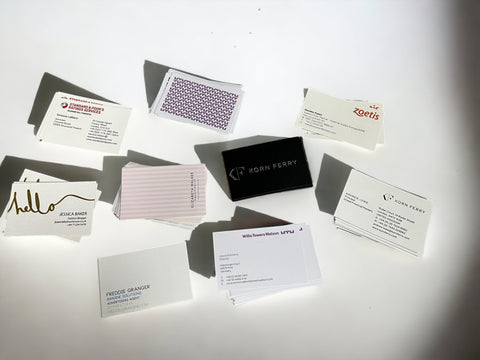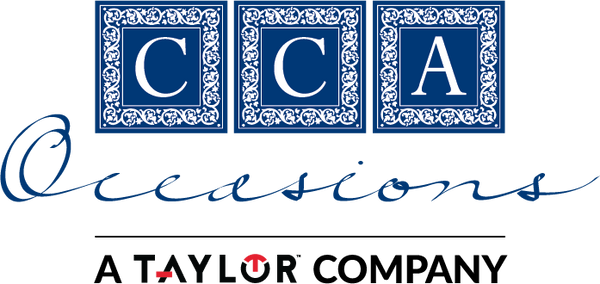Business Stationery

Business Identity Stationery: Crafting a Lasting Impression
In the ever-evolving world of business, establishing a strong and memorable brand identity is crucial. Your brand identity is more than just a logo; it's a holistic representation of your company's values, personality and mission. One integral component of this identity is business identity stationery. These printed materials, such as letterheads, business cards, envelopes, and more, play a significant role in shaping your professional image and making a lasting impression on clients, partners, and stakeholders.
The Role of Business Identity Stationery
Business identity stationery serves multiple purposes within an organisation, encompassing both form and function. It goes beyond being a mere vessel for conveying information; it's a tangible embodiment of your brand. Here's how business identity stationery contributes to your corporate image and success:
1. Brand Consistency:
Consistency is the cornerstone of a strong brand identity. Your stationery should reflect the same visual elements, typography, colors, and logo as the rest of your branding materials. This consistency reinforces brand recognition, making your business easily identifiable and memorable.
2. Professionalism:
High-quality stationery exudes professionalism and attention to detail. When you hand someone a well-designed business card or send a formal letter on a branded letterhead, you convey competence and dedication to your craft. This professionalism can foster trust and confidence in your organisation.
3. First Impressions:
First impressions are often formed based on physical materials. The look and feel of your business stationery set the stage for the interactions to come. A well-crafted stationery package can create a positive initial impression that piques the interest of clients, partners, or investors.
4. Communication:
Stationery serves as a means of formal communication. It facilitates the exchange of information, from official documents and contracts to simple introductory notes. Professionally designed and branded stationery can enhance the perceived importance and authenticity of the message.
Key Components of Business Identity Stationery
- Letterhead:
The letterhead is a vital component of business stationery. It typically includes your company name, logo, contact information, and often a corporate tagline. The design should be simple yet visually appealing, allowing ample space for correspondence. A well-structured letterhead conveys professionalism and is a platform for official communications.
- Business Cards:
Business cards are pocket-sized representatives of your company. They should include your name, job title, company name, logo, contact information, and often the company's website. Design elements should be consistent with the rest of your branding. A well-designed business card can leave a lasting impression and provide a quick reference for potential clients or collaborators.
- Envelopes:
Custom envelopes featuring your company's logo and return address not only look professional but also reinforce brand recognition. They are an essential part of your stationery kit, used for mailing letters, contracts, invoices, and other important documents.
- Compliment Slips:
Compliment slips, or "with compliments" cards, are smaller pieces of stationery that can be included with shipments, deliveries, or thank-you notes. They are a subtle yet effective way to reinforce your brand identity and convey appreciation.
- Notepads:
Custom notepads can be a valuable addition to your stationery kit. They can be used for internal note-taking or distributed as promotional items to clients. A branded notepad can be a practical and lasting reminder of your company.
- Folders:
Presentation folders are excellent for organising and presenting documents to clients or partners. They often include pockets for materials like brochures, business cards, or proposals. Custom folders with your company's branding can enhance the professional image of your organisation.
- Invoices and Receipts:
Even your financial documents can contribute to your brand identity. Customised invoices and receipts with your company's logo and contact information reinforce professionalism and consistency throughout the customer experience.
Design Principles for Effective Business Identity Stationery
Creating effective business identity stationery involves more than just placing your logo on a piece of paper. It requires careful consideration of design principles to ensure that your stationery conveys the right message. Here are some key design principles to keep in mind:
1. Brand Consistency:
Your stationery design should align with your existing brand guidelines. Ensure that fonts, colors, and logos match other branding materials like your website, signage, and marketing collateral.
2. Simplicity:
Clean, uncluttered designs are often the most effective. Simplicity enhances readability and keeps the focus on your message and brand. Avoid overcrowding the stationery with excessive design elements.
3. Typography:
Select typefaces that are legible and in harmony with your brand's personality. Typography plays a significant role in the overall aesthetics and readability of your stationery.
4. Color Palette:
Use a consistent color palette that aligns with your brand's color scheme. Colors evoke specific emotions and can influence how your brand is perceived.
5. Imagery:
If you use imagery, ensure it's relevant to your brand and message. Avoid generic stock photos that don't resonate with your identity.
6. White Space:
Don't be afraid of white space. It can improve the overall layout and readability of your stationery, allowing the recipient's eyes to rest.
Printing and Paper Quality:
Invest in high-quality printing and paper. The tactile experience of touching and holding your stationery can leave a lasting impression. Quality paper and printing can also enhance the visual impact of your branding.
Sustainability:
Consider using eco-friendly paper and environmentally responsible printing practices. Sustainable choices in your stationery can appeal to environmentally conscious clients and partners.
Customisation:
Tailor your stationery to your specific needs. Not all businesses require every component of stationery, so customise your package to match your communication requirements and budget.
The Evolution of Digital Stationery
In an increasingly digital world, physical stationery continues to hold value, but it is often complemented by its digital counterparts. Digital stationery includes email signatures, digital letterheads, and templates for electronic documents. These digital elements should also reflect your brand identity, ensuring a seamless transition between physical and digital communications.
The Importance of Rebranding
Over time, a company's brand identity may evolve or require a refresh. When rebranding, it's crucial to update all business identity stationery to reflect the new design and message. This ensures a consistent and cohesive brand image and helps prevent confusion among customers and partners.
Conclusion
Business identity stationery is more than just a collection of printed materials; it's a reflection of your brand's essence and professionalism. These materials are instrumental in making a positive impression on clients, partners, and stakeholders. A well-designed and consistent stationery package enhances brand recognition, fosters trust, and reinforces the overall image of your organisation. In an age where digital communication is predominant, physical stationery retains its significance, serving as a tactile and memorable representation of your brand identity. Careful consideration of design principles, customisation, and sustainability will ensure that your business identity stationery effectively communicates your brand's values and leaves a lasting impression.
